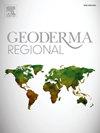采样频率对丹麦长期监测网络中有机碳含量观测动态的重要性
IF 3.3
2区 农林科学
Q2 SOIL SCIENCE
引用次数: 0
摘要
监测土壤有机碳(SOC)含量对于了解农业土壤在固碳和减缓气候变化中的作用至关重要。然而,采样频率对有机碳含量趋势准确性的影响仍然是一个悬而未决的问题。本研究调查了不同采样间隔对丹麦长期土壤监测网络(SMN)土壤的影响,其中包括自1986年以来的十年(每10-12年)和更频繁(30年7-11次)采样,后者最初收集(并存档)用于分析土壤矿物氮。我们的研究结果表明,年代际采样有效地捕获了长期的有机碳含量趋势,与更频繁的采样相比没有显著差异。土壤有机碳含量的年变异性很高,表明短期波动可能掩盖了长期趋势。当分析多年期的有机碳含量趋势时,这种变异性会减少。为了平衡资源限制和时间分辨率的需要,我们建议可以实施3-5年的抽样方案,其中每年对SMN站点的一个子集进行抽样。这种方法可以提供更精细的时间细节,而无需每年进行监测,同时保持检测有机碳含量动态趋势的能力。从业务角度来看,每年只对一小部分地点(例如,20 - 30%)进行抽样,以便在监测期间最终对所有地点进行抽样的轮转或滚动抽样策略,也将有助于保持现场专业知识和实验室能力的连续性,确保长期以来数据质量的一致性。本文章由计算机程序翻译,如有差异,请以英文原文为准。
Importance of sampling frequency for the observed dynamics of SOC content in the Danish long-term monitoring network
Monitoring soil organic carbon (SOC) content is crucial for understanding the role of agricultural soils in carbon sequestration and climate change mitigation. However, the influence of sampling frequency on the accuracy of SOC content trends remains an open question. This study investigates the effect of different sampling intervals using soils from the Danish long-term Soil Monitoring Network (SMN), which includes both decadal (every 10–12 years) and more frequent (7–11 times over 30 years) sampling since 1986, where the latter samples were originally collected (and archived) for analysis of soil mineral nitrogen. Our results show that decadal sampling effectively captures long-term SOC content trends, with no significant differences compared to more frequent sampling. Year-to-year variability in SOC content was high, suggesting that short-term fluctuations may mask long-term trends. This variability is reduced when SOC content trends are analysed over multi-year periods. To balance resource limitations with the need for temporal resolution, we suggest that a 3–5 year sampling scheme could be implemented, where a subset of SMN sites is sampled each year. This approach would provide finer temporal detail without the cost and effort of annual monitoring, while maintaining the ability to detect meaningful trends in SOC content dynamics. From an operational perspective, a rotational or rolling sampling strategy where only a fraction of sites (e.g., 20–30 %) are sampled each year such that all sites are eventually sampled in the monitoring period, would also help to maintain continuity of field expertise and laboratory capacity, ensuring consistent data quality over time.
求助全文
通过发布文献求助,成功后即可免费获取论文全文。
去求助
来源期刊

Geoderma Regional
Agricultural and Biological Sciences-Soil Science
CiteScore
6.10
自引率
7.30%
发文量
122
审稿时长
76 days
期刊介绍:
Global issues require studies and solutions on national and regional levels. Geoderma Regional focuses on studies that increase understanding and advance our scientific knowledge of soils in all regions of the world. The journal embraces every aspect of soil science and welcomes reviews of regional progress.
 求助内容:
求助内容: 应助结果提醒方式:
应助结果提醒方式:


